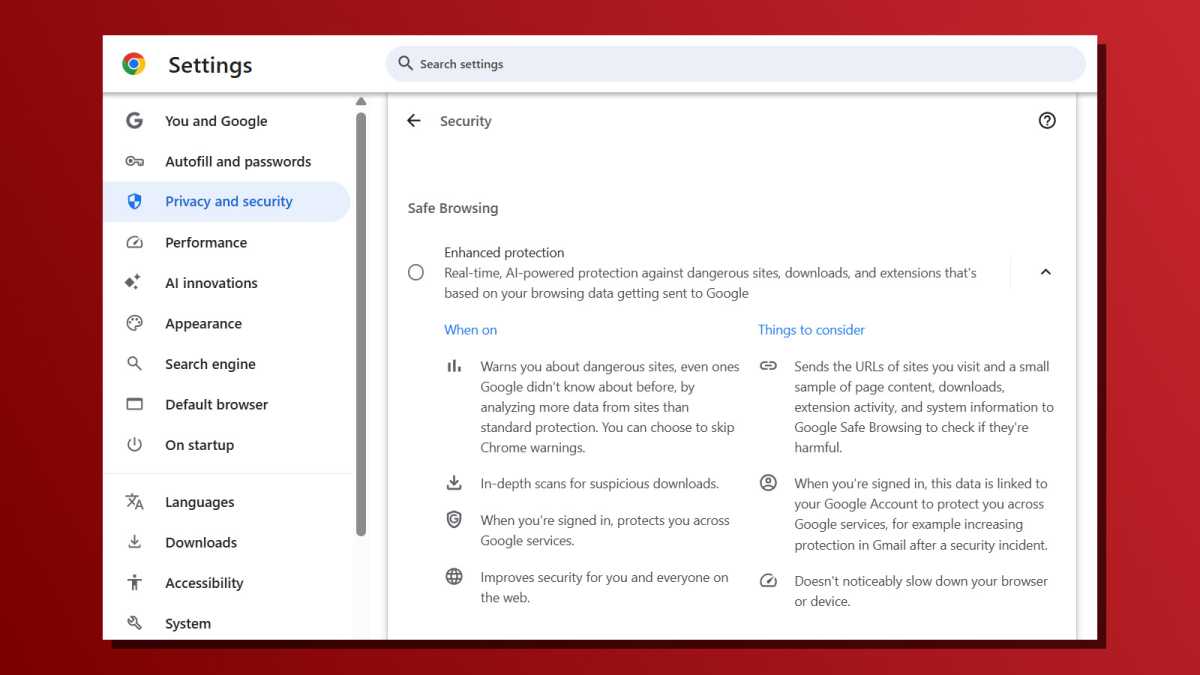- Регистрация
- 17 Февраль 2018
- Сообщения
- 38 934
- Лучшие ответы
- 0
- Реакции
- 0
- Баллы
- 2 093
Offline
Chrome's Enhanced Safe Browsing feature now uses AI to recognize online threats as they surface.

Image: Shutterstock.com
Google’s Chrome browser has a feature called Enhanced Safe Browsing that uses real-time AI-powered techniques to protect users against online threats. Unlike the more basic Safe Browsing feature, which compares visited addresses against a database of known dangerous sites, Enhanced Safe Browsing uses AI to recognize yet-unknown threats.
Google hasn’t published exact details on how Enhanced Safe Browsing works, only vague explanations like “in-depth scans for suspicious downloads” and “improves security for you and everyone on the web.”
Furthermore, Enhanced Safe Browsing is less private than standard Safe Browsing. Enhanced Safe Browsing “sends the URLs of sites you visit and a small sample of page content, downloads, extension activity, and system information to Google Safe Browsing to check if they’re harmful” and “this data is linked to your Google Account to protect you across Google services, for example increasing protection in Gmail…”

Google Chrome has a new AI-powered feature called Enhanced Safe Browsing that’s designed to protect users against dangerous sites and downloads.
Joel Lee / Foundry
Still, if you want real-time protection against zero-day threats like malware and fraudulent sites, you’ll be better protected with Enhanced Safe Browsing enabled. But Enhanced Safe Browsing isn’t enabled by default, so you’ll have to enable it manually if you want it.
To do this, click on the three-dot menu at the top-right of the browser, then navigate to Settings > Privacy and security > Safe Browsing and select “Enhanced protection.” Use the arrow button on the right side to open up explanations for each setting level.
This article originally appeared on our sister publication PC-WELT and was translated and localized from German.
Author: Roland Freist, Contributor, PCWorld

Roland Freist is a freelance IT journalist covering topics related to Windows, applications, networks, security and the Internet.
Recent stories by Roland Freist:

Image: Shutterstock.com
Google’s Chrome browser has a feature called Enhanced Safe Browsing that uses real-time AI-powered techniques to protect users against online threats. Unlike the more basic Safe Browsing feature, which compares visited addresses against a database of known dangerous sites, Enhanced Safe Browsing uses AI to recognize yet-unknown threats.
Google hasn’t published exact details on how Enhanced Safe Browsing works, only vague explanations like “in-depth scans for suspicious downloads” and “improves security for you and everyone on the web.”
Furthermore, Enhanced Safe Browsing is less private than standard Safe Browsing. Enhanced Safe Browsing “sends the URLs of sites you visit and a small sample of page content, downloads, extension activity, and system information to Google Safe Browsing to check if they’re harmful” and “this data is linked to your Google Account to protect you across Google services, for example increasing protection in Gmail…”

Google Chrome has a new AI-powered feature called Enhanced Safe Browsing that’s designed to protect users against dangerous sites and downloads.
Joel Lee / Foundry
Still, if you want real-time protection against zero-day threats like malware and fraudulent sites, you’ll be better protected with Enhanced Safe Browsing enabled. But Enhanced Safe Browsing isn’t enabled by default, so you’ll have to enable it manually if you want it.
To do this, click on the three-dot menu at the top-right of the browser, then navigate to Settings > Privacy and security > Safe Browsing and select “Enhanced protection.” Use the arrow button on the right side to open up explanations for each setting level.
This article originally appeared on our sister publication PC-WELT and was translated and localized from German.
Author: Roland Freist, Contributor, PCWorld

Roland Freist is a freelance IT journalist covering topics related to Windows, applications, networks, security and the Internet.
Recent stories by Roland Freist:
